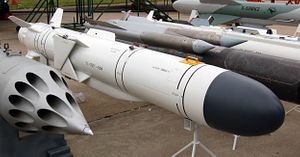On February 8, 2015, North Korea test fired five of what it termed “cutting edge” anti-ship missiles. Strategic political analysis would indicate that the date of the test firing holds more significance, as Pyongyang has chosen to showcase its latest naval armament upgrade a few weeks before annual U.S.-ROK military exercises, which the former regards as invasion rehearsals. While the missile testing was conducted to convey Pyongyang’s displeasure to Washington and Seoul, the successful testing of anti-ship missiles at a range of 200 km, as reported by South Korea’s defense ministry, is a development of note but not of alarm.
No ‘Silver Bullet’
According to knowledgeable analysts, the DPRK’s latest weapon appears to be a Russian Kh-35 anti-ship missile, which the North Koreans christen the “KN-09” and claim as their own. Assuming that the KN-09 shares the same technical and performance specifications as the Kh-35, whether as a renamed Russian import or a reverse engineered copy, it can be argued that the DPRK’s newest anti-ship missile is an attempt at economical force modernization rather than a “silver bullet” to counteract ROK naval superiority.
Considering the missile inventory of the Korean People’s Navy (KPN), we can see that its earlier anti-ship missiles ranging from the Soviet SS-N-2 Styx to the Chinese Silkworm and CSS-N-8 Saccade were developed from the 1950s to the late 1980s, and could be considered outdated. With the introduction of the KN-09 or Kh-35, the DPRK now has a modern missile which was deployed in Russian service as recently as 2003.
When making the case for KN-09 deployment as a force modernization measure, rather than as a short cut to negating South Korean naval preponderance, it would help to compare the characteristics and capabilities of the Kh-35/KN-09 with the American made Harpoon anti-ship missile used by the ROK navy. Examining the latest versions of both missiles, we can see that they have similar ranges (260 vs 278 km), are guided by onboard inertial navigation and active radar homing, are sea skimming (to reduce detection probability) while being day/night capable, and even have similar warhead weights and speeds (0.8 vs 0.7 Mach).
Factoring in the funding limitations the DPRK military faces given North Korean economic weakness, the KN-09 can be seen as a symbolic move to match South Korean naval prowess in the field of anti-ship capabilities. Specifically, the Russians sell the Kh-35 at $500,000 apiece, but a reverse engineered KN-09 would be more affordable due to cheaper local labor. In contrast, the Harpoon missile costs $1.2 million each.
However, missiles and other armaments alone do not determine naval power. Even if the modernization of the KPN’s fleet is accounted for, and deployment of the KN-09 amongst the DPRK’s surface fleet (it is not submarine launchable) maximized, the ROK navy would still prevail in any open seas conflict.
Lackluster Fleet
Simply put, the upgrading of the North Korean Navy (for which the KN-09 was the most recent feature), does not change the balance of naval power vis-à-vis South Korea. Excluding the ROK’s destroyers, the latter still has the former outmatched. Considering any DPRK attempt to challenge the ROK in the East or West Sea away from near coastal waters, it can be shown that the ROK has the quantitative edge in frigates and corvettes (30 vs 12), and fast attack craft and large coastal patrol vessels (81 vs 59). Even though the KPN has far more submarines (70 vs 15) and numerous small patrol vessels/torpedo boats, the latter’s submarines are less capable, and are of limited sea denial value given advanced South Korean anti-submarine warfare capabilities. As for the North’s numerous small craft, these lack sufficient range for extended operations beyond near coastal waters.
Turning to qualitative comparisons, the DPRK is upgrading one of its 1970s era Najin-class frigates with new fire control systems, radar, automated 30mm cannon and KN-09 missiles while introducing two new helicopter carrying anti-submarine warfare Nampo-class corvettes. However, these upgrades simply allow the KPN to fractionally match the ROK Navy’s older fleet of eight Ulsan-class frigates which have contemporary fire control radar, submarine hunting sonar, electronic counter measures systems, and are armed with modern Harpoon missiles and Blue Shark torpedoes.
As for fast attack craft and submarines, the North recently built three Nongo-class fast attack craft with purported stealth features and armed with KN-09 missiles, while also constructing a Sinpo-class submarine possibly incorporating Yugoslavian and Russian designs from the 1960s to the early 1980s. But despite such fleet modernization, the Nongo and Sinpo-class vessels are still outclassed by their ROK Navy contemporaries, the Gumdoksuri-class patrol vessels and the Chang Bogo-class submarines. The Gumdoksuri-class features leading-edge combat management systems and Harpoon equivalent missiles, and the Chang Bogo-class, underwent systems upgrades from 2000-2009.
The Real Worry
Having seen that Pyongyang’s latest sabre rattling episode in particular and naval modernization in general does not portend any destabilizing changes to the status-quo on the Korean peninsula, the real concern for North Korea’s neighbors remains its nuclear arms program. Indeed, any significant increase in North Korean nuclear warheads from the 12 it is currently believed to possess along with the demonstration of a reliable intercontinental ballistic missile would be a serious cause for concern. That, however, is a topic for another commentary pending further developments.
Nah Liang Tuang is an Associate Research Fellow at the Institute of Defence and Strategic Studies, a constituent unit of the S. Rajaratnam School of International Studies (RSIS), Nanyang Technological University.
































